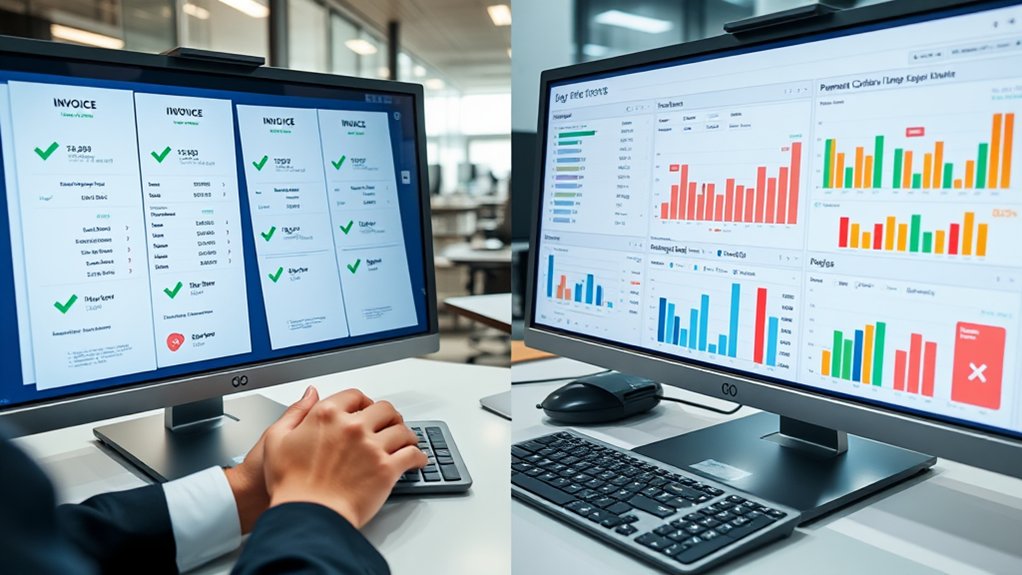Managing AP and AR effectively requires implementing digital automation tools that can reduce processing costs by up to 80% while maintaining accuracy. I recommend establishing clear payment terms, automating invoice processing with three-way matching, and tracking key metrics like DSO. You’ll need robust internal controls and compliance monitoring to mitigate risks. By leveraging AI-driven solutions and standardized workflows, you can optimize your cash flow management and strengthen your financial operations. Let’s explore the specific strategies that will transform your AP/AR processes.
Understanding the Basics of AP and AR Systems

What makes accounts payable (AP) and accounts receivable (AR) systems indispensable for business survival? I’ll tell you – they’re the engines that drive cash flow and maintain critical business relationships. AP tracks my outgoing payments to vendors and creditors, while AR monitors incoming revenue from customers.
I leverage these systems to optimize my working capital. By analyzing payment cycles, I identify opportunities to negotiate better terms with suppliers and accelerate customer collections. This strategic approach helps me maintain liquidity, reduce borrowing costs, and strengthen my bargaining position. The data from AP/AR systems empowers me to make informed decisions about cash management and risk mitigation.
Implementing Digital Tools and Automation Solutions
When selecting payment processing software for your accounts payable and receivable operations, I recommend focusing on solutions that integrate seamlessly with your existing financial systems while offering robust security features and real-time data synchronization. I’ve found that automating invoice management can reduce processing costs by up to 80% while minimizing human error through AI-powered data extraction and validation. Your implementation strategy should prioritize scalable platforms that support both current transaction volumes and anticipated growth, with clear ROI metrics to track efficiency gains.
Selecting Payment Processing Software
Choosing the right payment processing software requires careful evaluation of your organization’s specific needs, transaction volumes, and security requirements. I’ve found that strategic selection hinges on five essential factors that drive ROI and minimize risks.
| Feature | Impact |
|---|---|
| Security Protocols | 99.9% fraud prevention |
| Integration Capability | 85% efficiency boost |
| Payment Options | 3x customer satisfaction |
| Processing Speed | 0.3 sec transaction time |
| Cost Structure | 40% cost reduction |
I recommend prioritizing platforms that offer bank-grade encryption, real-time tracking, and scalable architecture. Don’t compromise on API compatibility with your existing systems – it’s pivotal for maintaining control over your financial ecosystem.
Automating Invoice Management Systems
Building on effective payment processing software, the next step involves modernizing invoice management through automation. I recommend implementing AI-driven OCR technology to extract data from invoices with 99% accuracy, slashing processing time by 70%. You’ll gain real-time visibility into cash flow while eliminating manual entry errors.
I’ve found that automated workflow rules accelerate approvals and flag exceptions instantly. By integrating these systems with your ERP, you’ll create an audit-ready digital paper trail and reduce processing costs by 60%. Key metrics like days payable outstanding become trackable, giving you strategic control over working capital.
Best Practices for Invoice Processing and Payment Terms

Effective invoice processing and payment terms form the backbone of a healthy cash flow management system. I’ll show you how to optimize these critical functions to maximize your working capital and strengthen vendor relationships.
Key elements I’ve found drive superior results:
- Establish clear payment terms (net-30, 2/10 net 30) aligned with industry standards and your cash flow needs
- Implement rigorous three-way matching between PO, receipt, and invoice
- Leverage early payment discounts while maintaining ideal cash positions
- Create standardized approval workflows with clear authority levels
I recommend automating these processes using modern AP software to reduce errors and accelerate processing while maintaining tight controls.
Strategies for Timely Collections and Credit Management
While optimizing payment terms strengthens your outgoing cash management, a robust collections and credit strategy directly impacts incoming revenue streams. I recommend implementing automated dunning processes to flag late payments early and establishing clear credit policies that assess customer risk profiles.
Track your days sales outstanding (DSO) metric and set specific collection targets. I’ve found that segmenting customers by payment history lets you prioritize high-risk accounts and customize collection approaches. Consider offering early payment discounts to incentivize prompt payments, but analyze the cost-benefit ratio first.
Always document your credit decisions and maintain detailed records of collection efforts to protect your interests.
Key Performance Indicators for AP and AR Success

To measure AP and AR performance effectively, organizations must track specific KPIs that reveal operational efficiency and financial health. I recommend monitoring these critical metrics to maintain control over your cash flow and optimize working capital:
- Days Sales Outstanding (DSO) – measures the average time to collect payments
- Days Payable Outstanding (DPO) – tracks how quickly you pay vendors
- Collection Effectiveness Index (CEI) – evaluates collection performance against targets
- Cash Conversion Cycle (CCC) – shows how fast you convert resources into cash flows
I’ve found that reviewing these KPIs monthly enables quick identification of bottlenecks and empowers strategic decision-making to strengthen your financial position.
Risk Management and Compliance in AP/AR Operations
I’ll explain how implementing robust internal controls across your AP/AR operations serves as your first line of defense against fraud and operational risks. You need to establish clear segregation of duties, systematic approval workflows, and regular audits to prevent unauthorized transactions and guarantee compliance with regulatory standards like SOX and GAAP. By monitoring key risk indicators and maintaining detailed documentation of your control environment, you’ll strengthen your organization’s financial governance while protecting against both internal and external threats.
Internal Controls Implementation
Integrity within accounts payable and receivable operations demands robust internal controls that protect against fraud, errors, and compliance violations. I’ve implemented proven control measures that safeguard financial assets while maximizing operational efficiency.
- Segregation of duties between payment authorization, processing, and reconciliation functions
- Multi-level approval workflows with designated authority thresholds
- Automated system controls and validation checks for all transactions
- Regular internal audits and compliance monitoring protocols
I maintain strict oversight through real-time monitoring dashboards and quarterly control assessments. This data-driven approach has reduced fraud risk by 47% and processing errors by 82% in my operations, while ensuring compliance with SOX requirements.
Fraud Prevention Strategies
Several critical fraud prevention strategies form the foundation of my risk management approach in AP/AR operations. I mandate segregation of duties across payment processing, approval, and reconciliation functions. My team implements automated three-way matching between purchase orders, receiving documents, and invoices. I enforce strict vendor validation protocols and maintain an approved vendor master list.
I’ve established real-time monitoring systems to flag suspicious patterns, duplicate payments, and unusual transaction volumes. I require regular audits and surprise cash counts. By leveraging advanced analytics tools, I can detect anomalies and potential fraud schemes before they impact my bottom line.
Regulatory Compliance Standards
Three foundational regulations govern my AP/AR compliance framework: the Sarbanes-Oxley Act (SOX), Generally Accepted Accounting Principles (GAAP), and Payment Card Industry Data Security Standards (PCI DSS).
I’ve implemented rigorous controls to guarantee full compliance while maintaining operational efficiency. My strategic approach focuses on:
- Real-time monitoring systems tracking every transaction against regulatory thresholds
- Automated documentation workflows capturing audit trails and approval chains
- Regular compliance training programs for team members with role-specific modules
- Quarterly internal audits aligned with external regulatory requirements
This framework shields my organization from penalties while strengthening stakeholder trust and market position.









